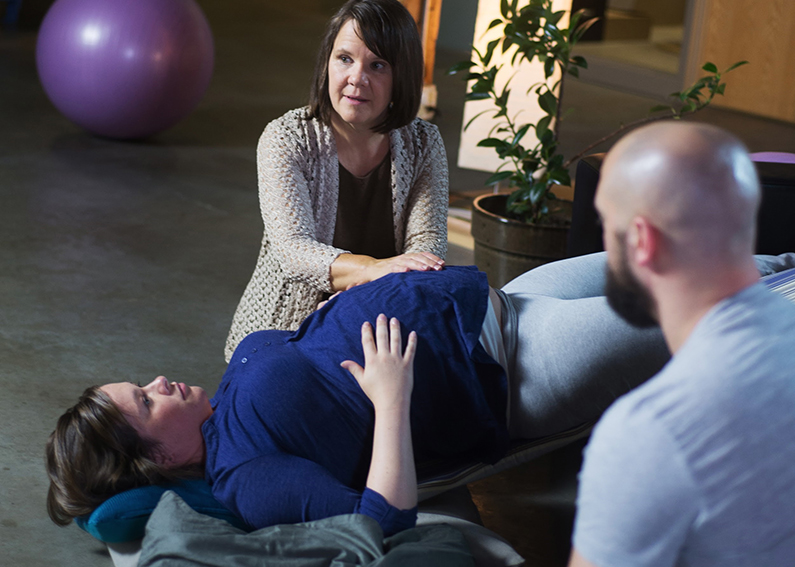
Flip a Breech? What we teach here at Spinning Babies® is a gentle, body balancing approach. We begin with the principles of Spinning Babies; Balance before Gravity and Movement.
For pregnancy self-care or things to do at home, we include five main techniques to turn a breech baby head down. These are all on our website at our Flip a Breech page. After doing this series of activities, your breech baby may turn after one day, or in a week or two weeks, or, it’s true, your baby may not turn for no fault of yours or your baby’s. Your doctor may attempt to turn your baby at 36 or 37 weeks pregnant and after you do these activities, they may be more successful than usual (50% success is considered good success). When a doctor or midwife tries to turn your baby by hand it’s called an external cephalic version (ECV). For parent’s reading this, an ECV is a procedure your doctor, or rarely, a midwife may do to turn your baby by moving baby by pressing on your abdomen.
With these home activities for turning a breech, there will be more babies turning. Of the babies that do turn, more turn at ages under 35 weeks than later in pregnancy. But even for those trying these activities first time after 35 weeks, we believe their babies have an increased chance of turning. Some will turn with ease even up to 40 weeks, most will need several days of activities and many, at that late gestation, may need professional bodywork. Some won’t turn at all and sometimes, for no reason we can understand.
Here’s what a person carrying a breech baby and their partner or friend can do the week before an external cephalic version. The idea here is to give room for baby to turn. The person pregnant with a breech baby will need a sensible adult helper. On the final day, arrange a day around a series of 7-14 Forward-Leaning Inversions and 3 Breech Tilts in addition to the other three techniques. The series of 7 FLIs can be done with less days of preparation if there isn’t that time before an ECV, scheduled cesarean, or labor. If one starts in the afternoon, continue on during the next day; but do not set an alarm to wake for inversions!
Seven seems effective for most breech babies to turn. Adrienne Caldwell, my advisor on body balancing, suggests 14. She’s no skimper.
The first four of these techniques can begin after 20 weeks for any pregnancy, any baby position. But begin the fifth technique only after the 30th week. After 32 weeks, don’t wait to begin once you know there are no medical reasons not to be upside down.
Don’t do any techniques if there is vaginal bleeding or signs of premature labor. Medical reasons to avoid the Forward-leaning Inversion include recent surgery or hypertension to name two common ones. Don’t do Sidelying Release if you have hypermobility.
Avoid the Breech Tilt before 30 weeks.
A large baby can still turn at 40 weeks, it’s just not as common as a baby turning earlier. The state of the uterine ligaments and abdominal muscles, as well as the fascia all around the abdomen, may help this be more likely.
Schedule the appropriate week for helping baby get “Bums Up.”
After 32 weeks, try these five techniques daily for 5 days in a row.
Parents: Breech Tilt means to get on an ironing board or other board that is the height of your knee over the floor at one side. Use a pillow under your shoulders and back to prevent your neck from pressing your chin into your chest during the Breech Tilt but let your chin touch your chest during Forward-Leaning Inversion – quite the opposite for these two inversions.
Alternatively, do the Open-knee Chest properly with knees only about hip-width apart but quite far from your abdomen, so use a wall to press your feet on, and a pillow under your chest (not head) to support you.
You will need to arrange a sensible helper with you all day, perhaps your birth partner, partner, friend or doula, to help you with several techniques. Set out 3 big jars of water, some nuts, and berries for snacks (or other yums) and be proud of yourselves!
There are two inversion styles you will do this day. One is for making room for baby to settle head down. We do that one first, that’s the Forward-Leaning Inversion. Then once there’s more assumed space in the lower uterine segment, the Breech Tilt allows the baby to back up out of the pelvis if needed but mainly to come rest their head in the fundus which may help them tuck their chin, which is necessary for the baby to lead the flip.
These five techniques plus our Bums Up 6-day program work for many pregnant parents who see their baby turn. If this hasn’t worked, seek professional help. We have a Professional Help page at Spinning Babies. See more at Flip a Breech.
Providers and Parents: I hope this was helpful. Knowing how to do these activities correctly is as important as knowing when going upside down is not safe for medical reasons. Please look at the Spinning Babies website and not parent posts on social media, or even our shared posts of parent photos since the enthusiasm to share photos supersedes correct technique. Look at our techniques pages for current instructions and up-to-date safety additions.
[tribe_events_list limit=”4″]
One of our most beloved products, now with subtitles in English, French, and Spanish, offering expert support to reduce intervention and increase comfort throughout pregnancy and birth.